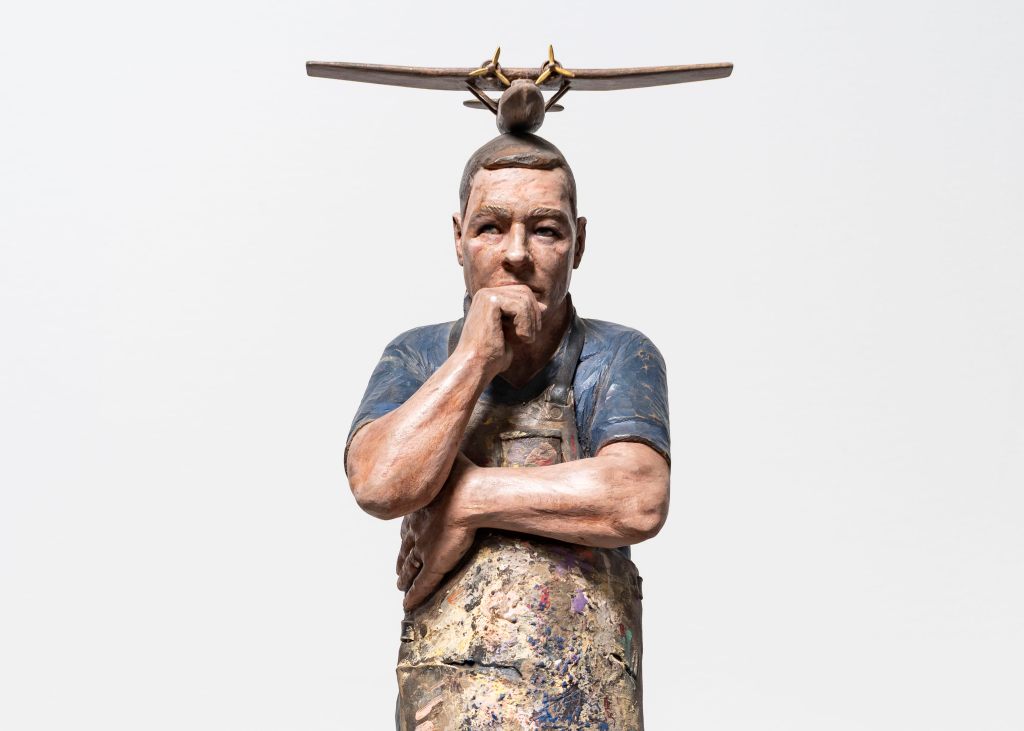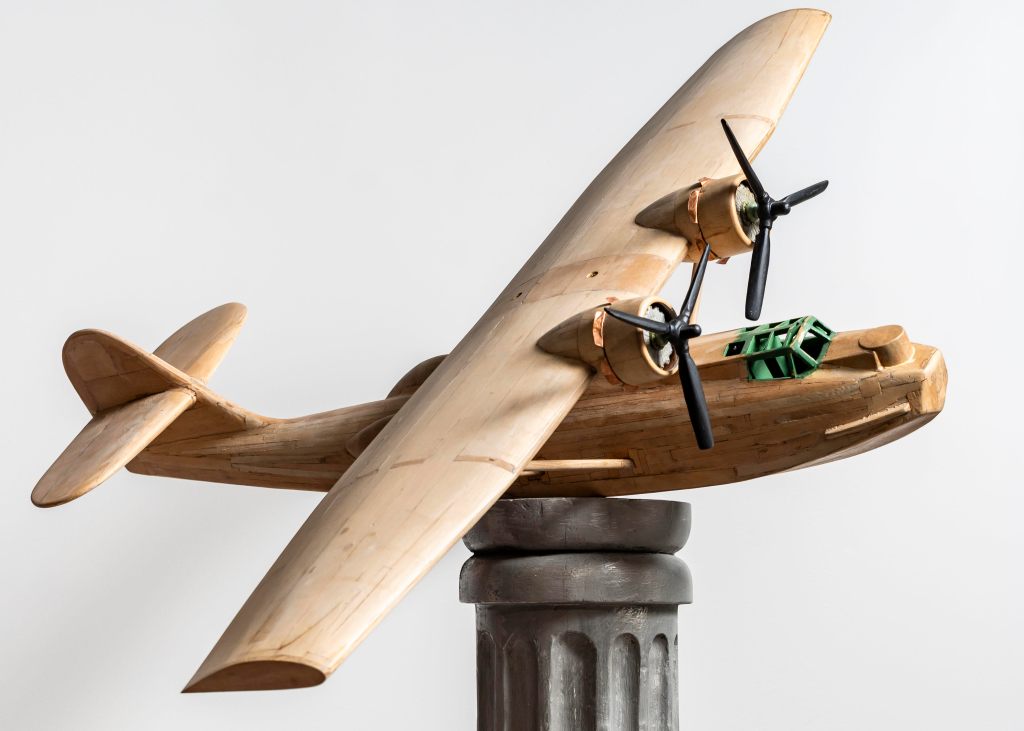High flyer – the art of re-shaping the past
Brisbane sculptor Stephen Hart is known for his extraordinary creations and his resurrected Catalina is one of the most intriguing – and personal – yet.

Stephen Hart has spent two years creating a sculptural Catalina aircraft at one-eighth scale.
Replicating a machine is a departure within Hart’s practice, which for five decades has focussed on humans – the habits and complexities of modern society. Yet the Catalina sparked the Brisbane-based artist’s imagination as a boy and emerges from his early family life.
The Consolidated PBY Catalina seaplane was developed in the 1930s and ’40s to become one of the most widely used during World War Two, particularly in the Pacific where it was important in the war against Japan. It featured in his father’s war in New Britain and became an imaginative vessel into which he dreamed his childhood.
Hart says that this project has required precision, engineering and mathematics and has stretched his mental – and physical – capabilities. His ideas were initially tested with drawings, research and calculations. He has worked with materials unfamiliar to him – including surfboard foam and rubber – and 13,000 rivets were used to replicate the craft’s aluminium surface.
Only in recent days, with the wings proving strong enough to secure the hanging of the aircraft, has he been confident that it will be ready for its launch at FireWorks Gallery at Bowen Hills in Brisbane on September 4.
‘in the last two years with global instabilities, the Catalina has been part of my personal quest to find the light’
You might like
“It is a great relief to be at this final stage with the physical completion close,” Hart says. “Its reception – as art – is also something that I have been concerned about. The abject (subjects that confront topics often hidden or denied) is part of so much contemporary work, but I am more interested in art that uplifts and moves me. Henry Moore believed that it was the artists’ role to stimulate vitality and reflect the positive.
“I guess that, in the last two years with global instabilities, the Catalina has been part of my personal quest to find the light. I have the determination to see it through that I am aware of (was) in my father, who survived the war in Rabaul, under the most difficult conditions. I am still working through what the Catalina means, but making the sculpture is, I think, part of understanding the stories and perseverance in my own background.”
Hart is best known for his exploration of the human condition, often through the body, with his Fellow Humans seen at the Museum of Brisbane in 2014. It was noted for its hand-carved and polychromed assembly of Hart’s friends, family and colleagues in a uniquely Brisbane series of connections – personal, professional and through social networks. The exhibition celebrated and affirmed the value of the human circle. He was awarded a Churchill Fellowship shortly afterward to travel the world to examine the shifting meaning of the human body from historical art to the contemporary and into the public realm.
Other more recent work by Hart includes Pertinacity (2022), which evokes the human scale amid the forests of South-East Queensland, reflecting the solace nature provided for him during COVID-19 isolation.
The Catalina was an idea prompted by seeing the seaplane on the floor of the Powerhouse Museum in Sydney in early 2024.
He had been without a studio for two years after his Teneriffe studio in inner-Brisbane flooded, the second “once in a lifetime” flood that impacted him in 2022 (and before that in 2011). This flood drove Hart’s move to a new, purpose-built studio well above the flood line. However, it was 2024 by the time his tools, power saws and equipment were installed in the new space and he could begin work again.
Subscribe for updates
The Catalina will be shown along with other recent sculptures that depict the power of the idea – dream (2024), with the Catalina sitting on his head, describing his inability to let the idea go – despite the difficulties which he ultimately worked through. the cat comes back is another (smaller) iteration of the Catalina sitting atop a fluted column, its height above the eyeline suggesting the aspiration in its ambition.

This recent project has also inspired the production of Hart’s second monograph, with contents curated by artist and book designer Michael Phillips (and me), and significant forewords contributed by artist Adrian Hall and poet Nathan Shepherdson.

The latter has added his musings to a 48-page poem. Shepherdson writes, “Five minutes into my conversation with Stephen Hart, it became apparent his Catalina project was about his father. Poems now complete, questions continue to alternate, to democratically leapfrog their role and purpose. Is the plane created to fly to his father, or his father to fly to him? Do father and son alternate between each other’s bodies? Do they both in fact take turns in being the plane?”
Hart found, too, that the Catalina resonated with other individuals, some of whom – ex-ABC broadcaster Bernie Bowen and Frank Turner (father of Flight Centre’s Graham “Skroo” Turner) – have allowed their own Catalina stories to be included in the book.
The book’s design reflects the many decades of Hart’s artist journals, which are central to his practice. They include biographical material, ideas and inspiration, and trace the wars, suffering and technological developments of his time through drawings, notes, photographs and newspaper clippings.
FireWorks Gallery director Michael Eather believes Hart is a “Brisbane treasure” and “one of the most skilful and dedicated sculptors working today”.
“His ability to materialise his universal wonderment and metaphysical themes within a personal narrative is fascinating, ” says Eather.
This exhibition promises to uplift a wide audience. The Catalina’s wingspan is four metres, with its empty cockpit an invitation to the audience to also imaginatively occupy this seaplane – which was, in its time, an engineering and aeronautical triumph.
the cat came back: Stephen Hart sculpture, FireWorks Gallery, Bowen Hills, Brisbane, September 4 to October 18, with opening night on September 13, 4pm-6pm; and an artist talk with Stephen Hart and poetry reading by Nathan Shepherdson on September 26, 5pm-7pm.
the cat came back: Stephen Hart sculpture book is soon to be published and distributed by AndAlso Books; andalsobooks.com
Free to share
This article may be shared online or in print under a Creative Commons licence

